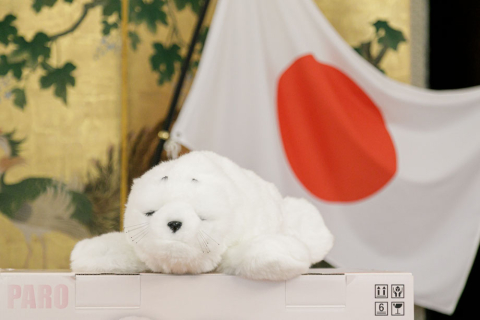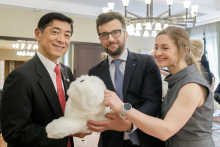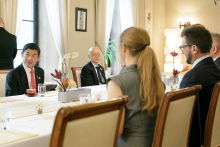In a recent meeting, Miyajima Akio, the Japanese Ambassador to Poland, handed over paro robots to Prof. Paweł Włodarski, Vice-Rector for Internationalization, Promotion and Development of the Medical University of Warsaw. The event was also attended by Dr. Magdalena Łazarewicz from the Study of Health Psychology at the Medical University of Warsaw, the coordinator of the CM WUM University Psychological Clinic as well as representatives of the JETRA foundation and the Mazovian Neuropsychiatry Center, who also received PARO robots.
They work like zootherapy
PARO is a medical therapeutic robot that looks similar to a young Greenland seal. It was invented by Prof. Takanori Shibata. The device has touch, light, sound, temperature and position sensors which, thanks to its built-in artificial intelligence, send it stimuli coming from its surroundings. For example, thanks to these touch sensors, it distinguishes stroking from impact and acts accordingly. The robot also reacts to its name, and can also learn desirable as well as undesirable types of behavior. It works on the principle of biofeedback and is classified as biofeedback equipment. It is worth 6 thousand dollars. "So far, the use of PARO for working with elderly people with dementia and psychosis; somatic patients, including cancer sufferers; war veterans as well as people with post-traumatic stress disorders etc, has been recorded," says Dr. Magdalena Łazarewicz. The operation of a robot can be compared to zootherapy. Just like a relationship with a real animal, contact with PARO raises the patient’s level of dopamine, serotonin, oxytocin and endorphins, and thus improves the patient’s mood and reduces his or her level of anxiety. It also assistants in establishing social relationships. - This method is relatively new but very promising, especially as a replacement for zootherapy where it is inaccessible, impossible or difficult to introduce – says Dr. Łazarewicz.
They won’t just be working in hospital wards
Currently, an optimal strategy being developed for using PARO to work with refugees from Ukraine. A team coordinated by Dr. Magdalena Łazarewicz from the University Psychological Clinic of the Medical Center of the Medical University of Warsaw and the Study of Health Psychology at the Medical University of Warsaw is working on it, in cooperation with the creator of PARO, Professor Takanori Shibata and his team from the National Institute of Advanced Industrial Science and Technology. - Amongst other things, we are planning action in refugee centres, kindergartens and primary schools, where we will try to help integrate Ukrainian and Polish children. We also have plans for robots to be used in clinical wards for individual actions to help hospitalized children from Ukraine, in particular war victims. We are also considering cooperating in the provision of medical transport for people from Ukraine as well as extra support for paramedics. There are a lot of ideas, and we are discussing them with specialists from Japan with a view to taking full advantage of the range of therapeutic properties that PARO has to offer – says Dr. Łazarewicz.
The PARO device is used in more than 30 countries. By July 2021, about 7,000 robots were in use. They were particularly popular during the COVID-19 pandemic. In Poland, they will be used for the first time.




